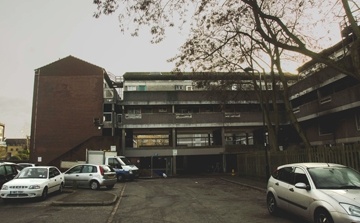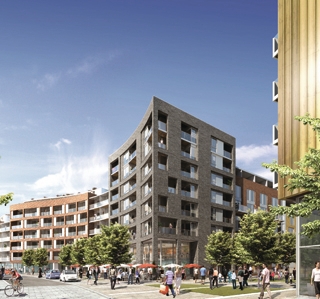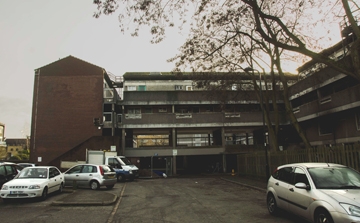You are viewing 1 of your 1 free articles
Green by name, green by nature
The Green Man Lane estate in west London is undergoing a £155 million ‘greenover’. Jess McCabe pays a visit to see the transition from concrete jungle to eco-development first-hand
Visiting the Green Man Lane estate in Ealing is like walking through a before and after picture. Most of the sprawling estate, on which about 1,000 people live in nine blocks, is made of particularly grim-looking concrete.
Damp has blackened the concrete under many of the windows, which are glazed only with a single panes of glass. Housing association A2 Dominion is one of the developers working on the Ealing Council site, and even one of the 34,000-home landlord’s own staff admits the place is ‘quite grim’.
In one corner of the estate, however, a £155 million makeover is under way - or, as it were, a ‘greenover’.
A car park that was no longer in use has been demolished, along with one block of flats, and a new building has been erected in their place. It is the first phase of the complete overhaul of Green Man Lane, meant to turn the estate from a concrete jungle, to a jazzy, doughnut-shaped new development designed by Jasper Conran’s firm of architects. And given the environmental credentials of the site, it is one that developers A2 Dominion and Rydon argue will put the ‘green’ back in Green Man Lane.
Entering the basement of the new block, the noise of machinery is overwhelming: it is the sound of the scheme’s brand new combined heat and power plant, which will soon take over supplying heat to the estate’s district heating system, and generate electricity for the communal areas. Residents of the new blocks, should they want to charge an electric car, will be able to do so in the car park underneath the block.
Ultimately, 464 homes will be demolished, to be replaced over nine years with 700 mixed-tenure homes. Phase one and two alone, which will build 342 homes, will cost £56 million. Phase one recently completed, and construction of phase two is about to start. Of the 176 homes built so far, 106 are affordable and social rent, 21 are for market sale and 49 for shared ownership. No estimates are yet available for how much phases three or four will cost, but they will more than double the number of homes.
Earlier this year, Sustainable Housing visited the site to see the transformation in progress.
Crumbling concrete
Originally built between 1971 and 1975, the Green Man Lane estate sprawls over 3.46 hectares behind bustling Ealing Broadway in west London. Anne Fabing, 68, moved into one of the blocks in 1978, at the age of 32, with her daughter. Her son was born the next year.
‘It was quite a nice estate at the time. Everybody knew each other,’ she recalls. ‘Over the years they started having problems that they couldn’t fix, because there was crumbling concrete.’

An old concrete block
In 2005, Ealing Council began to consider plans for the regeneration of the estate. A survey in 2007 found that 59 per cent of its residents were dissatisfied with Green Man Lane as a place to live. The council considered three options: refurbish parts of the estate using decent homes funding, partial redevelopment, and completely redeveloping the estate, funded by selling the land to a developer and cross-subsidising the new affordable housing with homes for private sale.
Eventually, it was this last option that won the day. In 2009, the development partner was selected by a joint venture set up by A2Dominion, which will let the homes - although Ealing Council will retain 100 per cent nomination rights - and contractor Rydon. The developer’s architect was Conran & Partners. A2Dominion was bidding for one of the largest regeneration projects in its own backyard - the landlord started life as Acton Housing Association. Bulldozers finally arrived and started work in 2011.
Based on consultation with tenants, the plans included an environmental upgrade of the estate. The concrete blocks would be replaced with highly insulated homes built to level 4 of the code for sustainable homes. Solar panels will contribute to carbon dioxide savings of 57 per cent, higher than the 44 per cent required to meet code level 4, according to Rydon. The estate’s ageing district heating system, run off gas, would be replaced with an upgraded energy centre. A community café, which had yet to open at the time of Sustainable Housing’s visit, promised acoustic guitar and poetry performances.
Opposition
Not everyone has welcomed the makeover, however. West Ealing Neighbours, a local residents’ group, is one of the main opponents - in part because the regeneration involved selling the land to the joint venture, taking it out of public ownership, and reducing the number of social rent homes from 391 to 338.
In August 2010, Eric Leach, vice-chair of WEN, issued a statement saying: ‘No compelling evidence has been presented to convince us of the need to demolish this estate. The estate has been poorly maintained and managed for decades. Effective maintenance and management could make the current estate viable for decades to come.’
Adding to the disgruntlement of local residents, original plans to include a gym on the site were shelved - apparently the lure of Ealing Broadway a few minutes’ walk away was too much to persuade businesses to install themselves on the estate. The space is being used to provide more homes instead.
Ms Fabing, however, is unimpressed with the views of WEN, whose members live near, but not on, the estate. ‘It’s really down to the people who live on the estate to decide what they want to have on the estate,’ she argues.
In February 2014, Ms Fabing moved into a sixth floor, two-bedroom flat in one of the new blocks, Chardon House (all the buildings have been named after old English apples, to honour Ealing’s distant past as an orchard).
Rent has risen - in the retired hairdresser’s case from £123 a week, to £155 a week.
‘People have been quite rude about their rents going up,’ she adds. But Ms Fabing says she is paying less, overall, because her energy bills have reduced from £120 a month to a fraction of that - she doesn’t know exactly yet, but she has only had her heating on five or six times since February, and it has cost about 50p a day, according to the smart meter installed in her flat.
‘I go around in T-shirts most of the time and I have no heating on,’ the 68-year-old points out.
Other residents on the estate will be watching closely as the new blocks go up, to see if the project delivers on its green promise for them as well.
Comment on this story at www.insidehousing.co.uk/eco









